Angkor Wat is a massive three-tiered pyramid six kilometers north of Siem Reap, crowned by five lotus-like towers rising 65 meters from ground level. The balance, composition, and beauty of the temples make the lost city of Angkor one of the world’s finest monuments. Unesco designated Angkor Wat as a World Heritage Site in 1992.
General Information
Angkor Wat is a massive pyramid structure built by King Suryavarman II, in Cambodia. The Angkor Wat compound is 1,500 by 1,300 meters in size and is surrounded by a massive moat 180 meters wide, 65 meters high, and divided into three layers. Balustrades shaped like giant serpents run along the causeway leading to the massive entrance gate, and are thought to represent cosmic fertility.
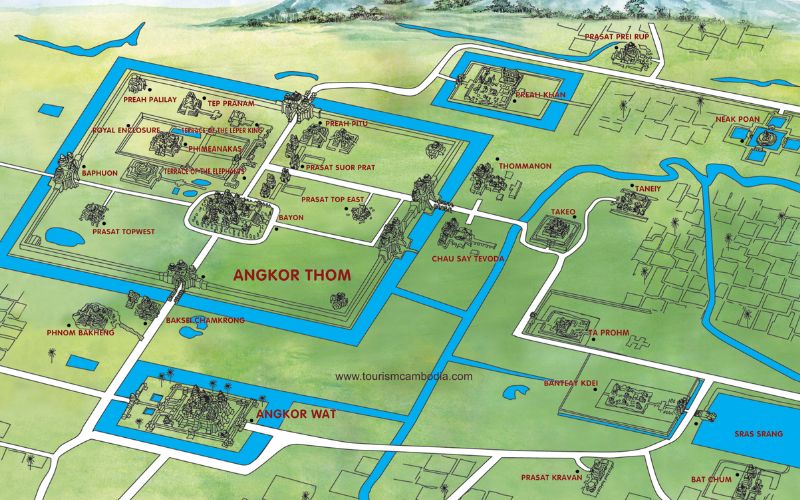
Angkor Wat map
The most famous Angkor decoration is the heavenly nymphs (Apsara) that are distinctively rendered on the walls. The central temple complex features an 800-meter-long bas-relief depicting the Battle of Kurukshetra, Suryavarman II’s Army, Heaven and Hell, the Churning of the Ocean of Milk, Elephant Gate, Vishnu Conquers the Demons, Khrisna and the Demon King, the Battle of the Gods and the Demons, and the Battle of Lanka. The most popular sunrise location is the northern reflecting pool in front.
Weather and best time to visit
Cambodia has no seasons, with only minor differences between the summer and winter months. The rainy season, which can provide an average of 15 rainy days per month and sometimes significant precipitation between May and October, has a significant impact. The climate around Angkor Wat is humid, with humidity levels reaching more than 90% during the rainy season. The air has become uncomfortably humid, almost unbearable, especially in the winding walls of Angkor.
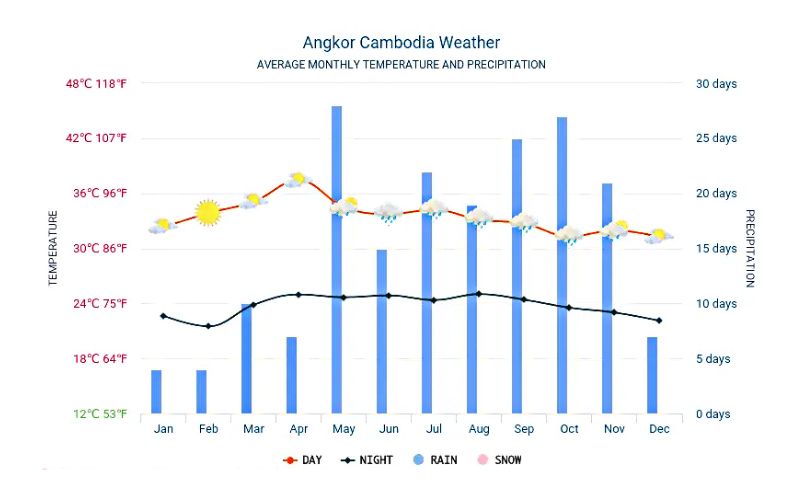
Angkor Wat weather
The Angkor region’s driest months are December and February, while temperatures begin to rise in mid-March. April is a dry month with an average day temperature of 35.8 °C.
Cambodia is said to be best visited during the cool dry season. However, for temple exploration, the wet season (May to October) is also a good time because the moats will be full and the foliage lush, albeit very soggy. Furthermore, it is recommended that the first visit to Angkor Wat be made during optimal lighting conditions, which are usually around one to two hours in the afternoon when the setting sun illuminates its west-facing main gate. Many visitors come just before dawn to see the first rays of light bounce off the magnificent temple as the sun peeks over the horizon. Seeing the sunrise at Angkor Wat is also a memorable experience.
Getting to & around Angkor Wat
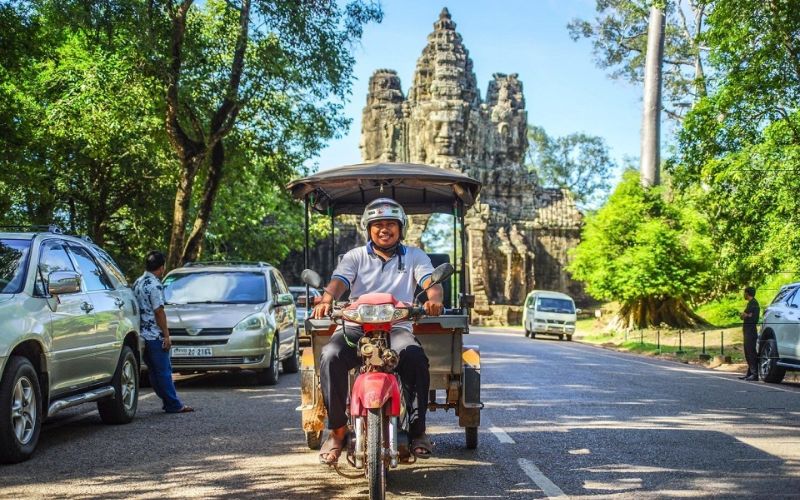
Tuk-tuk in Cambodia
Visitors can hire a local guide to explore the Angkor Archaeological Park (open daily from 5 a.m. to 6 p.m.). There are also bicycle rentals and tuk-tuks available for hire at reasonable rates.
Where to Stay in Angkor Wat
The temple complexes of Angkor (the former capital) have only a few restaurants and no accommodations, so visitors must stay in nearby Siem Reap to see the sights.
There are numerous lodging options in Siem Reap, the gateway city to Angkor and a city in its own right. There are numerous low-cost hostels as well as other excellent options like traditional homestays, villas, and even high-end hotels and resorts. If hotels are fully booked during peak season, you should book ahead of time.
Best places to visit & things to do in Angkor Wat
Angkor Wat
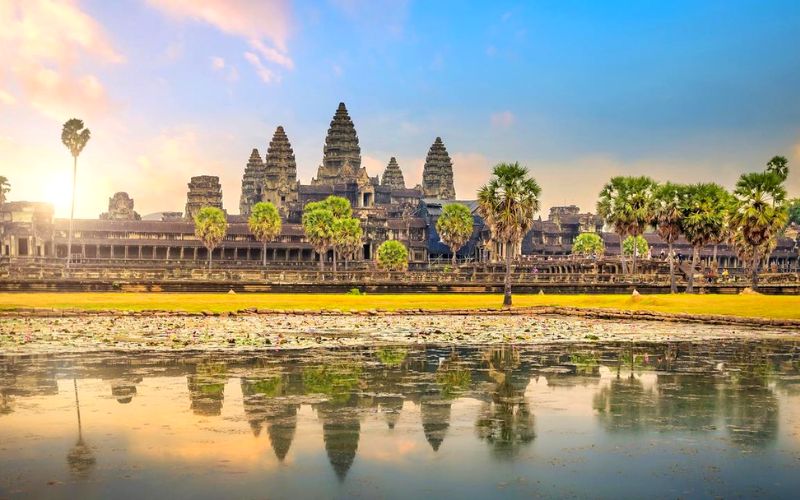
Angkor Wat
The Angkor Wat temple complex, rising from the jungle as the star of the UNESCO-listed Angkor Archaeological Park, is a 12th-century engineering marvel. In the shadowy corridors, look for intricate carvings of nymphs dancing on columns, serpent-topped balustrades, and massive, chiseled bas-reliefs depicting Khmer Empire battles. Although designed as a microcosm of the universe, the complex is easy to navigate and is divided into three tiers.
Bayon
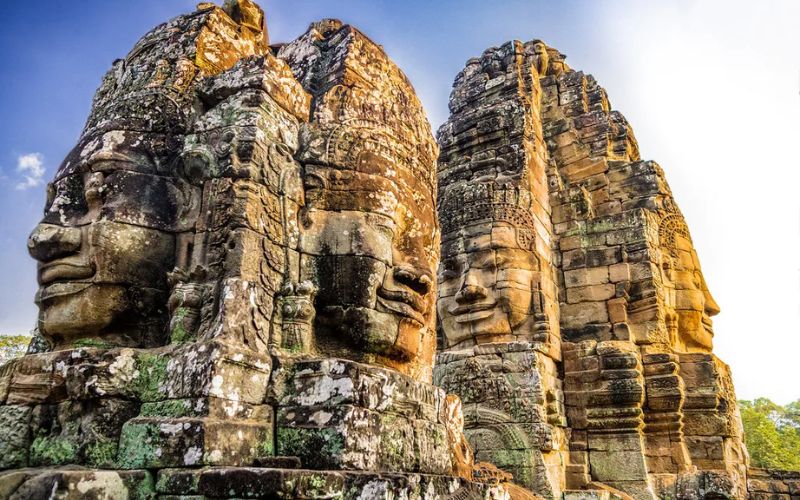
Bayon Temple
The Bayon, the geographical and spiritual center of the ancient city of Angkor Thom, is one of Khmer King Jayavarman VII’s crowning artistic achievements. Around 200 massive faces peer down from 50 towers, while beautifully crafted reliefs depict daily life in 12th-century Cambodia.
Banteay Srei
The delicately carved rose-pink temple of Banteay Srei is a masterpiece of Angkorian art, despite its small size. The name translates as “Citadel of the Women,” most likely due to the numerous carvings of “apsara” nymphs. It’s about an hour’s drive from the main archaeological area and was built in 967 AD, long before Angkor Wat or Angkor Thom.
Angkor Thom
Angkor Thom, an ancient Khmer capital once surrounded by a crocodile-infested moat, dwarfs Angkor Wat in both size and scale. Each of the site’s five gates is preceded by avenues lined with 108 deities representing good and evil, providing spectacular photo opportunities even before entering.
Ta Prohm
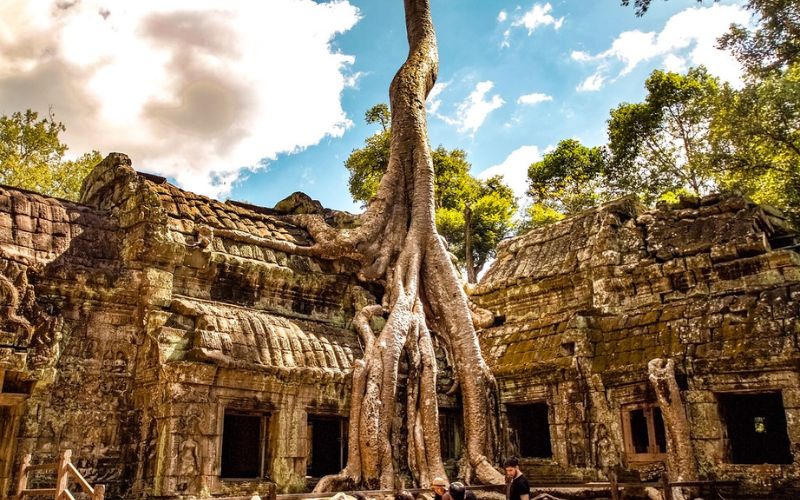
Ta Prohm
Ta Prohm, which Angelina Jolie explored in 2001’s Lara Croft: Tomb Raider, is widely known as “the Tomb Raider temple” of Angkor Wat. It’s one of Angkor’s—and Cambodia’s—signature sights, a 12th-century Buddhist monastery, and temple complex enmeshed in a web of towering tree roots that stands as an eerie symbol of the transience of human endeavor.
What to eat & drink in Angkor Wat
You can explore the local Khmer cuisine in Siem Reap, the gateway to Angkor Wat.
Pumpkin duck egg custard
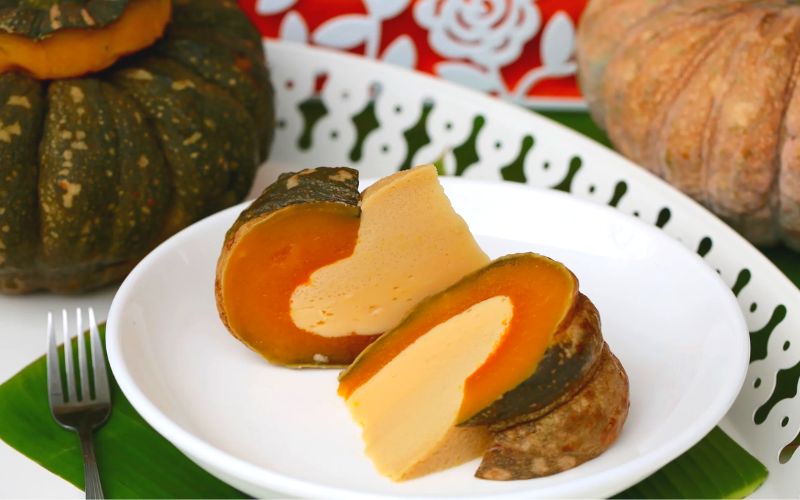
Pumpkin duck egg custard
The pumpkin duck egg custard is an intriguing dessert that is unexpectedly decadent. The pumpkin is hollowed out first to remove the seeds before a duck-egg custard mixture is poured inside. The entire thing is then cooked over a wood fire until the custard is done, and the dessert is served in cake-like slices. It’s satisfying without being overly sweet, with the perfect balance of custard and pumpkin.
Num banh chok
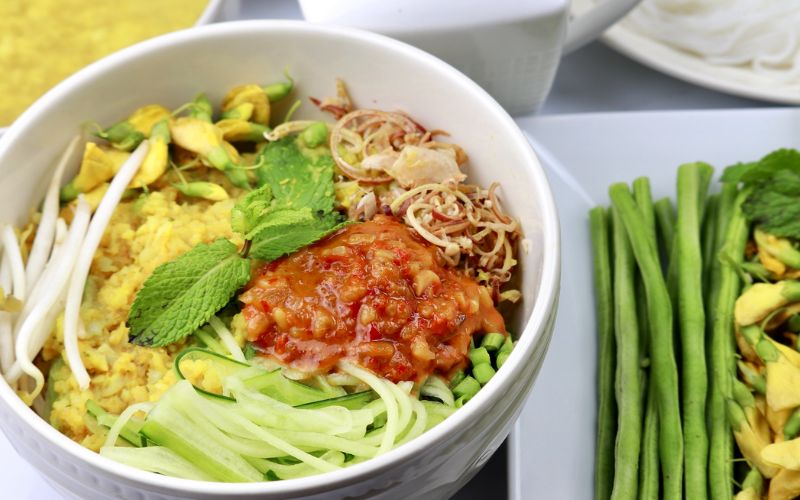
Num banh chok
Num banh chok is a rice noodle dish with herb-heavy coconut fish broth that is popular among locals in Angkor Wat for breakfast. The rice noodles are typically made from scratch, and the broth is made with lemongrass and other foraged herbs from the area. The noodles are topped with an abundance of raw greens, which makes for a refreshing combination. In the morning, the dish is sold on the street in small plastic bags.
Fish Amok
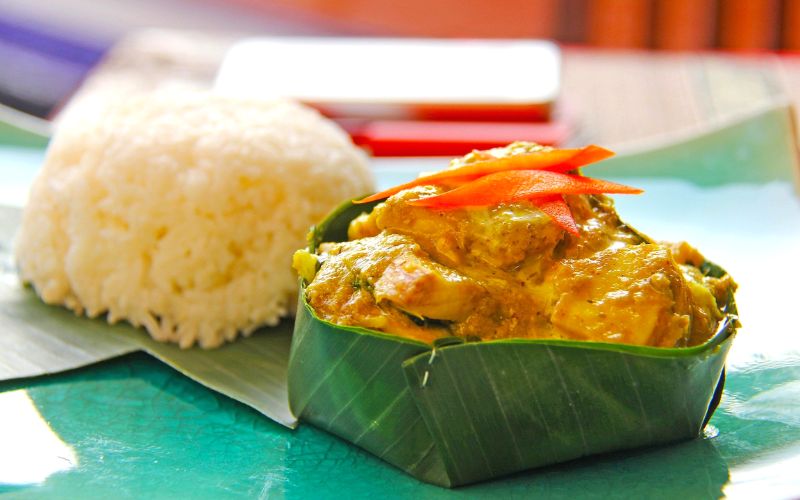
Fish Amok
Fish amok, also known as amok trei, is a Cambodian national dish consisting of steamed fish curry (amok) with a mousse-like consistency. This curry dish has a melting, warm flavor that combines local herbs like ginger and lemon with a kick of spice. This is, in fact, one of the must-try food if you come to Cambodia.
Prahok
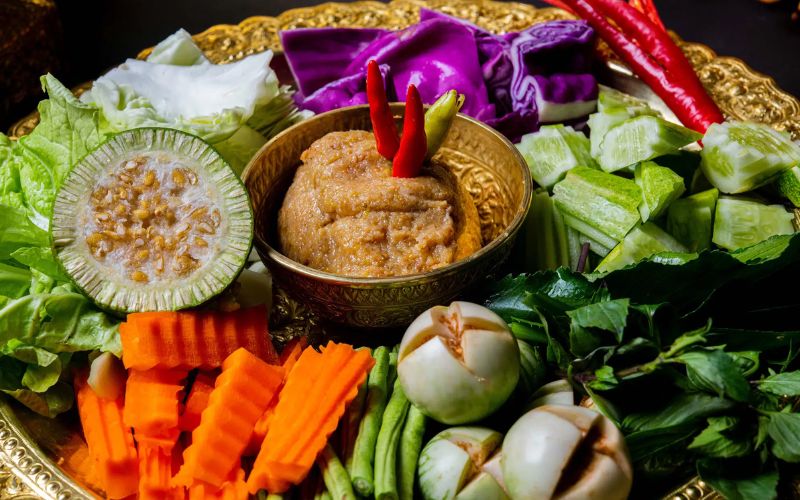
Prahok
Prahok, a fermented fish paste that can be eaten alone or as a condiment, is a popular local seasoning. It was first introduced as a way to preserve fresh fish and is also known as Cambodian cheese or the salt of Cambodia. While it is popular among locals, the scent can be overpowering for visitors.
Korko soup
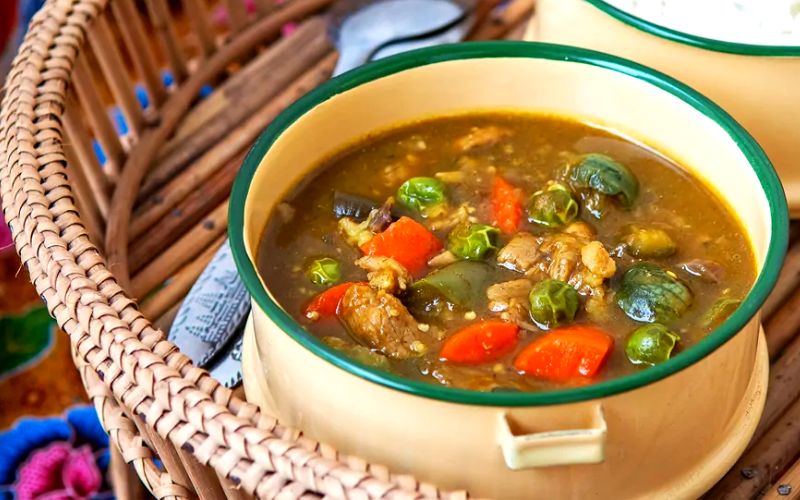
Samlor Korko
Korko soup, once a royal dish fit for a king, is also known as vegetable or stirring soup. Its ingredients include various vegetables and herbs that are constantly stirred, thus the name. While the name suggests that this is a vegetarian dish, korko soup is frequently prepared with chicken and fish paste.
Khmer herb cocktails
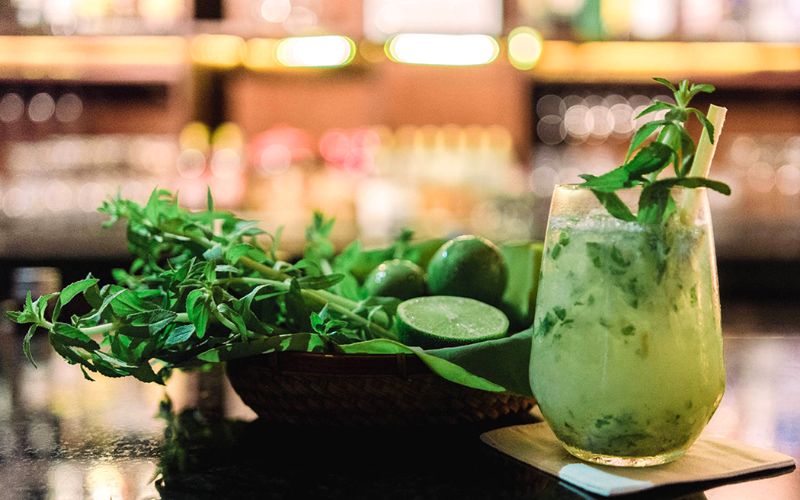
Khmer herb cocktails
While Siem Reap does not have its own signature cocktail, there are a few with a Cambodian twist. Cocktails like Tamarind Sauce incorporate local ingredients like rice paddy herbs, tamarind, and kaffir leaf, providing visitors with a one-of-a-kind beverage to complement their evening.
Travel tips
Wear light, airy, covering clothing while touring the temples to protect yourself from the sun and mosquitoes. Because the sun can be harsh, bring a hat, sunglasses, and possibly sunscreen. Consider buying a traditional Khmer scarf to keep the sun off your neck (krama). Carry a raincoat with you during the rainy season, even if you only need it in the afternoon. During the sunrise and sunset hours, you should have mosquito repellent on hand. When climbing narrow steps and walking on uneven terrain, wear appropriate footwear.
We hope the information in the article “Angkor Wat travel guide” will be helpful to you. If you want to have more information and ideas to build an unforgettable itinerary in Angkor Wat, do not hesitate to contact us!